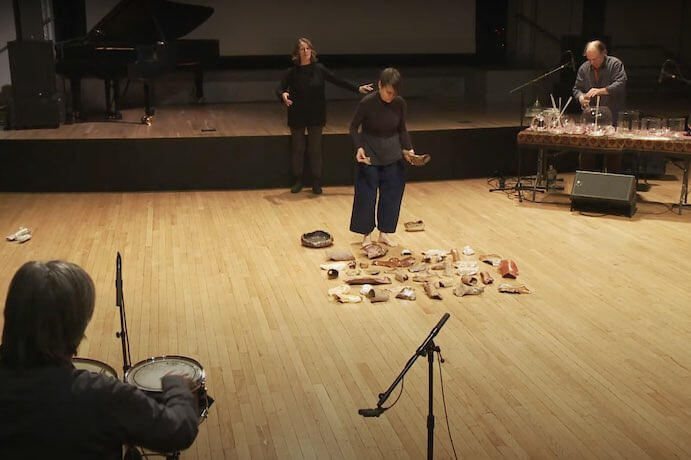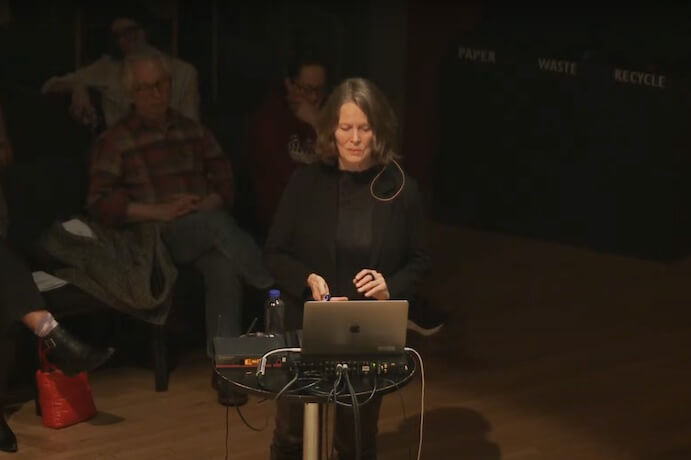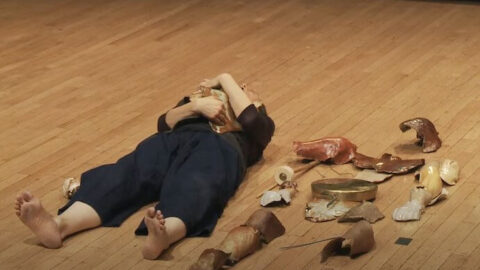A heap of ceramics sat in the middle of the floor at Roulette on Feb. 7, jumbled like a pile of jagged metal in a scrapyard, a tangle of curled edges colored in glossy, earthy tones. But upon closer inspection, they resembled something more human – toes and fingers protruded from the chunks of clay; another slab was shaped like a shin. Throughout the world premiere of Kristin Norderval and Friends’ What Comes Back to Us, the ceramics gradually unraveled, getting pulled apart and pieced back together again; they were stroked and tapped, held close and at a distance, like parts of ourselves strewn about and pouring out.
What Comes Back to Us is an abstract piece inspired by the past and its influence on the future. The eclectic group of performers included Norderval on vocals, laptop, and gestural controllers, Gustavo Aguilar on percussion, Miguel Frasconi on glass instruments and modular synths, and Jill Sigman dancing and interacting with the ceramics. This was their debut as an ensemble under the moniker Q4, but they all have histories of collaboration in different configurations — most notably, Norderval and Sigman have worked together for more than 20 years. As a quartet, they had a clear understanding and communication with each other. Much of their performance allowed each artist to speak their voice: Norderval’s haunted, reverberating vocals draped themselves over the pulsating rhythms of Aguilar’s percussion and the oceanic hums of Frasconi’s glass bowls, while Sigman’s frenetic gestures channeled and urged the music’s flow.

A nonlinear conception of time was the jumping off point throughout the piece, acting as a guidepost for its many twists and turns. As a whole, the piece was characterized by unpredictable movements, which felt like a representation of how past memories can flash back into consciousness at-random. The work was structured in large sections made up of reiterating phrases, but despite its circular form, the piece often felt disjointed, which occasionally took away from its overarching narrative. However, the small details of the piece were highly effective; it was intriguing to watch the tiniest ways that the performers evolved as the work unfolded.
Norderval opened the work with eerie, operatic singing from outside the room, while Frasconi sliced through them with jangling glass chimes. There were moments of near-silence — just a couple glass scrapes and the sound of Sigman’s shuffling feet against the wooden floor — then drums and modular synths entered, reaching a blistering pitch. Elsewhere, Aguilar blew into a hollow whistle while Sigman trembled and shook, a barren landscape that quickly shifted into squealing electronics and ghostly vocals.
The pile of ceramics started out in disarray, but Sigman took it apart and lined the individual pieces up like fossils in a diorama; later, she stacked them up in pairs, matching their ruffled edges. Sigman’s dance itself felt like a ritual representation of all the changes in the music and objects — she held her arms up in rigid lines while drums sounded a regular pulse, she ran around the players while electronics buzzed with fervor, and she was still while glass bowls rang.

Similarly, the textures and timbres of the music shifted, converging and diverging. Frasconi drove this motion, dragging glass against glass to create a variety of different screeching sounds; at one momentous point, he held a broken wine glass against a large chalice, forming a piercing wail. Norderval, too, morphed her voice, manipulating her murmurs into rippling echoes and layering melodies made of different hums and vibrations. At one point, she blew into a clay pot, forming a gentle rush that sounded like the inside of a conch shell against the ear – which contrasted with the moment she howled into a cavernous, open grand piano.
Yet it always came back to the ceramics. At the end of the work, Sigman amassed them in her arms, embracing them as if she never wanted to let them go. They almost spilled out of her arms as she gently laid down and a projected video began. Onscreen, there was an image of a forest floor with light green leaves and dirt. Two hands dug through them, removing the leaves to reveal soil, then bore deeper to find that the sepia-toned ceramics had been buried there. The hands dusted them off, unearthing them like pieces of the past born back to life.
I CARE IF YOU LISTEN is an editorially-independent program of the American Composers Forum, and is made possible thanks to generous donor and institutional support. Opinions expressed are solely those of the author and may not represent the views of ICIYL or ACF.
You can support the work of ICIYL with a tax-deductible gift to ACF. For more on ACF, visit the “At ACF” section or composersforum.org.
























